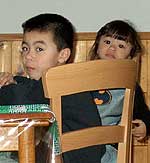By Brandt Williams
Minnesota Public Radio
April 10, 2002
The 2000 census was the first opportunity for Minnesotans to report their multi-racial heritage. Without past years of data to compare the numbers to, demographers don't know if the state's mixed race population is larger than 10 years ago. But they do know that the multicultural population is very young. That says a lot about the changing face of Minnesota.
| |
|
|
|
||
The census data released this week shows people who say they are both American Indian and white make up the majority of Minnesotans who reported multi-racial backgrounds.
The next largest multi-racial group is made up of people who are both black and white. Multi-racial people are more likely to live in Hennepin and Ramsey counties.
The state's multi-racial population is also young. The median age of multi-racial Minnesotans is about 17 - less than half of the median age of all state residents.
Minnesota is still overwhelmingly white. But demographers say this data shows that people of different racial and ethnic backgrounds are putting these differences aside, and having children.
This trend is represented by Camilo Gallego, 8, his brother Julian, 5, sister Elena, 2. On a recent morning, Julian and Elena are eating breakfast in their family's Carver County home while Camilo gets ready for school. Their mother, Jeunge Yang-Gallego, makes Camilo a ball of sticky rice filled with pork to eat before he leaves.
Jeunge is Hmong. Her husband Carlos was born in Minnesota, but his parents came to America from Columbia. Jeunge and Carlos have been married for 10 years.
| |
|
|
|
||
Carlos says his parents were a little nervous about his decision to marry an Asian woman. Jeunge says at first, her parents didn't want her to marry someone who wasn't Hmong.
"They want you to marry your same culture, because my mom can't speak English and cannot communicate with him, and it's really difficult," says Jeunge. "But later they think - if I'm happy, he's happy - then they agree."
The Gallego children speak Hmong, English and some Chinese and Spanish. Jeunge's father was Chinese. She wants the kids to reflect her Chinese heritage, as well as their Hmong and Latin ties.
According to the census, the Gallego children would be considered multi-ethnic, not multi-racial, since the census categorizes Hispanics as an ethnic group, not a racial group.
Minnesotans who come from at least two racial groups make up less than 2 percent of the state's total population, according to the 2000 census. But demographers say those numbers could increase in coming years.
State demographer Barbara Ronningen says the state is seeing the results of a trend towards interracial marriages.
| |
|
|
|
||
"It's become a more common thing to see mixed-race children. As that occurs nationally, it also has occurred in Minnesota," says Ronningen. "We probably (have) a much smaller mixed-race population than some states. But we've certainly seen changes - and a more open society perhaps - where you have mixed marriages and as a result, mixed race children."
Another way demographers track the growth of multi-racial populations is through household size. Ronningen says minority and multi-racial populations generally have more children than white families, and that means their numbers are growing.
She says the rate of growth will depend on other factors such as the economy. Ronningen says a faltering job market may cause many minorities - especially those who have just moved to the state - to relocate.
The Gallego family has lived in Chaska since October. The Gallego kids say they don't have any playmates who look like them. But their father Carlos says, like many parts of Minnesota, Chaska is slowly becoming more diverse.
"In the city of Chaska, there's been very little immigration of other cultures until very recently," says Carlos Gallegos. "As an example, there were less than 70 Hispanics in the 1990 census. Now there's over 1,000, just in the area of Chaska alone."
Carlos says on the 2000 census form, he classified his children as Hispanic-Asians.
In the 2000 census, there were a total of 885 people who called themselves Hispanic-Asians in Minnesota.
More Information


